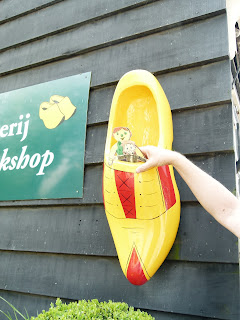Madurodam was started as a war memorial for a WWII resistance fighter who died in the Dachau Concentration camp. It is a 1/25th scale of the famous buildings, towns and other structures (such as working locks) in the Netherlands. The boats, trains (there are 2 miles of railroad track, cars are all run. Each building takes about 4 years to build!
 This is a statute of Hans Brinker saving his town by putting his finger in the dike.
This is a statute of Hans Brinker saving his town by putting his finger in the dike.This is a plane on the runway at Madurodam.
Here are the working locks.You can see one boat in the lock and another getting ready to enter.
This was a concert....people were even dancingand waving their arms. I took a video and hopefully will be able to load it up.
This is the replica of the Alkmaar cheesemarket...see the humans in the background.
These are delicious Dutch pancakes....and very different from ours. It is a mix of our pancakes and pizza. This one is half ham with cheese and the other half apples and cinnamon. They are served at special restaurants.
The hotel we stayed in when we were in Haarlam was a converted church built in the 1800's. This is a picture of the vaulted ceiling over our bed.
Another building from Madurodam.

















































